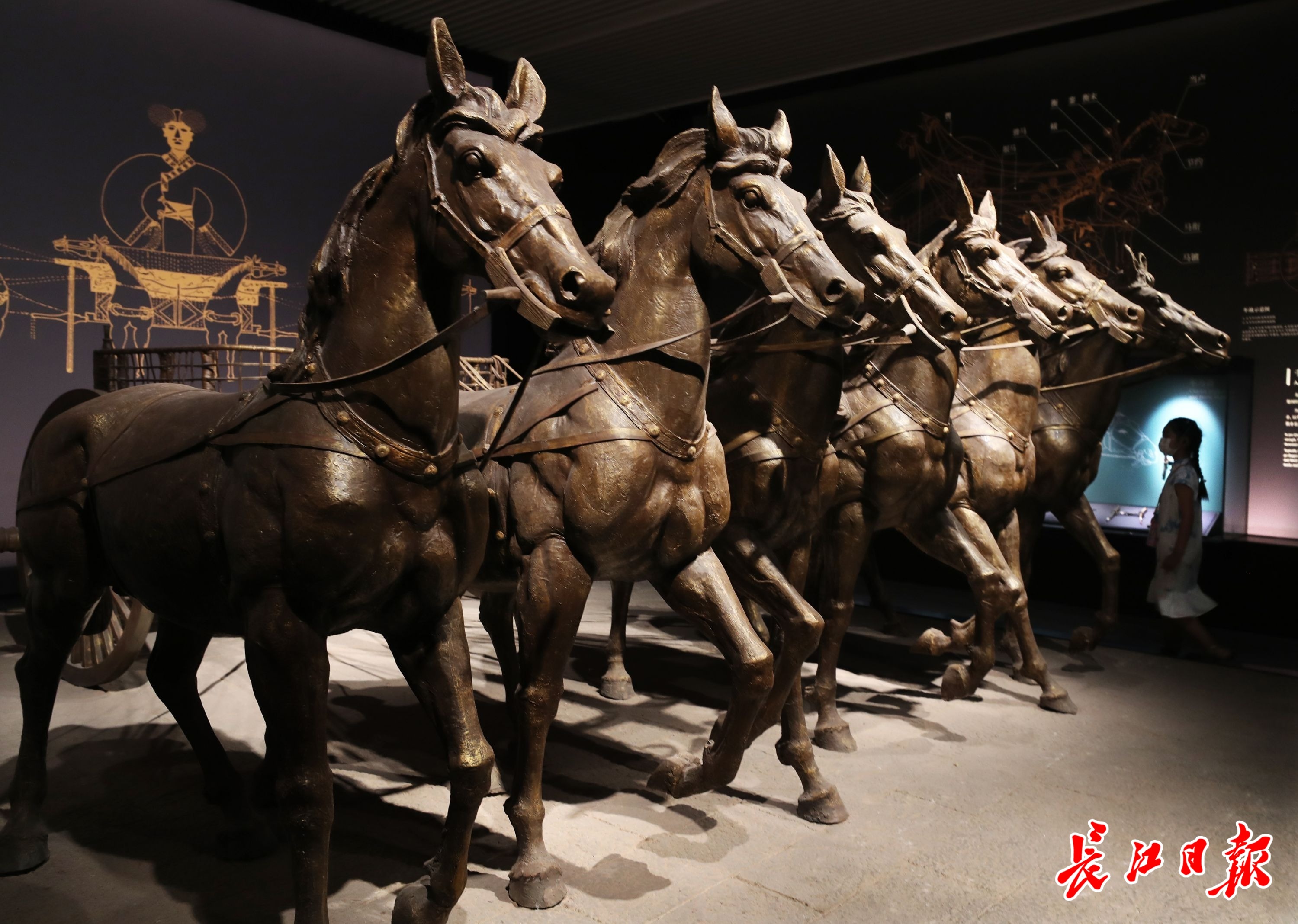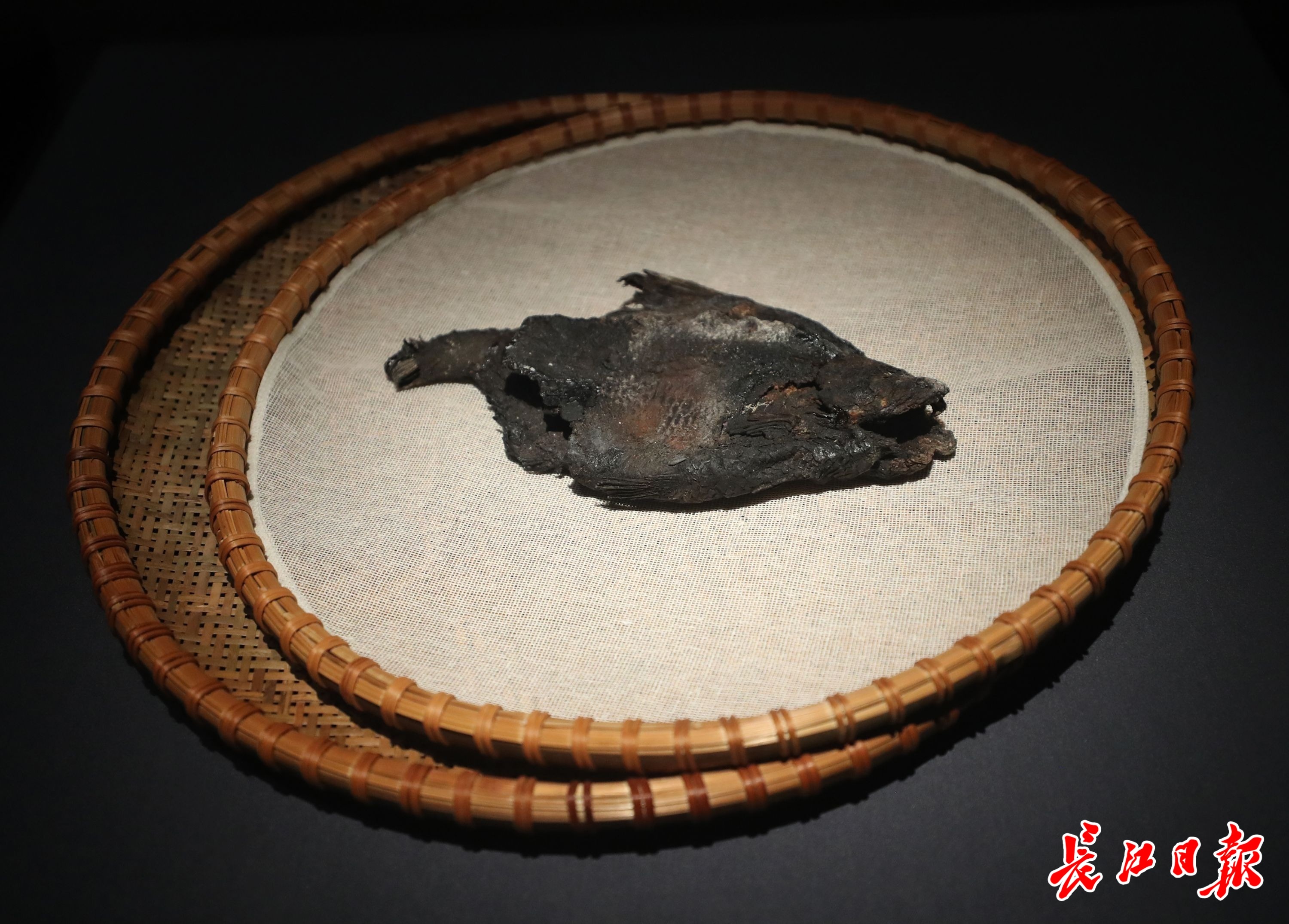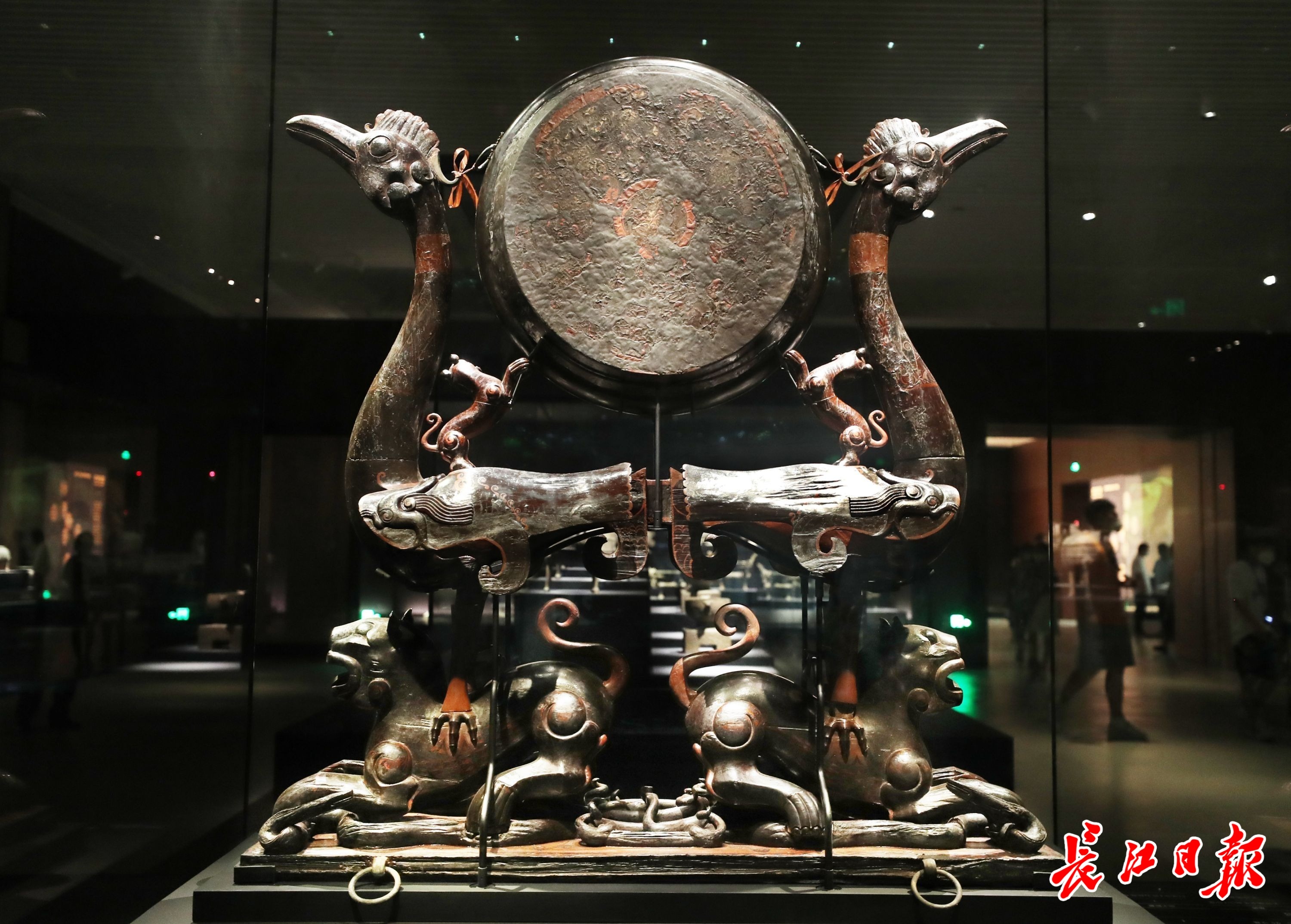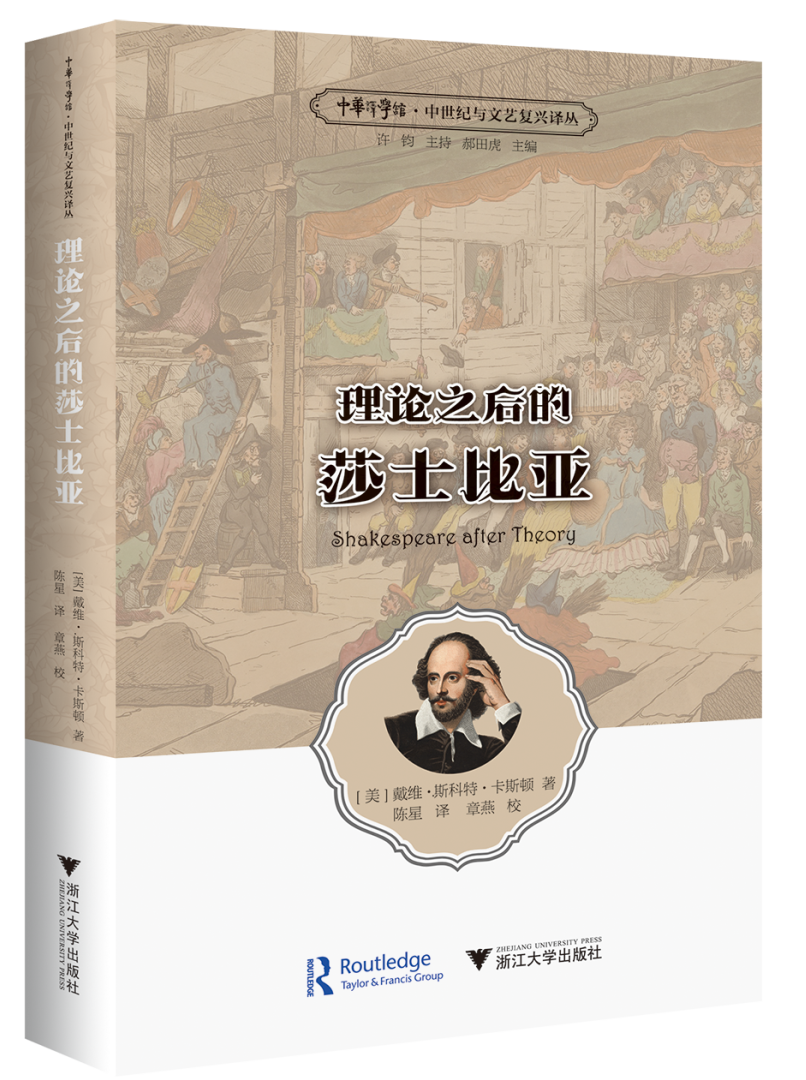Visit the Tuanye Night Exploring the Hubei Provincial Museum. More than 2000 years ago
Author:Changjiang Daily Time:2022.09.05
Explore the origin and development of the Chu State to understand the daily life of the Chu people. On the night of August 26th, the visiting group of "Reading China -Hubei Yangtze River" was visited at the 800 -year exhibition hall of the Chu State Museum in the Hubei Provincial Museum. The members of the group were amazed.
Zhou Yuan Oracle and Chu Jibao confirmed that Chu State originated in the early Western Zhou Dynasty

On August 26, a little girl at the Hubei Provincial Museum visited the "800 Years of Chu" exhibition. Changjiang Daily reporter Qiu Yan
"After the autumn, Chuzi came to the father", "Chu Bai Qiqiu is in the king's law", the Changfang Qin of the Hubei Provincial Museum told the visiting group members that these were a group of businessmen unearthed from Zhouyuan, Qishan County, Shaanxi Province in 1977. In the last week, the text on the Oracle in the early Zhou Dynasty confirmed the close relationship between Chu and Zhou. At the same time, during the twice excavations of the Yichang Wanfuyi site in 2015 and 2017, 12 pieces of the Western Zhou Dynasty were unearthed. One of them was engraved with the inscriptions "Chu Jibao Bell, Sun Nai was presented to the father -in -law, and the blessing of the blessing". National history and culture provides important information. "We found through these archeological discoveries that the founding of Chu was indeed in the early Western Zhou Dynasty."
The Chu Junshi schedule on the wall of the exhibition hall briefly records the 800 -year history of Chu. At the end of the business, the ancestors of the Chu people (yù) Xiong Xiong assisted Zhou Wenwang to achieve great careers. At the beginning of the Western Zhou Dynasty, King Zhou Cheng (from 1042 BC -reigned in 1021 BC) was divided into Xiong Yi in Jingshan, known as "Chuzi", but a hundred miles. After Xiong Yi was blocked, the Chu people led the people of the Chu people to "Lan Road and Qishan Forest". This spirit inspired the generation of King Chu to continue to work hard. Xiong Qu obtained copper ore resources, and the king of Chuzhuang "alarming" and "to the Central Plains". Chu Mourning Wang Ren used Wu Qi to change the method ... After hundreds of years of hard work, Chu State eventually developed into a large country with five thousand miles, ranking among the "Spring and Autumn Periods" and "Seven Heroes of the Warring States Period". The country's competing country, the territory from the west to the east of Sichuan, the east to the Jiangsu and Zhejiang, the south to the northern part of Guangdong, the north to Henan and southern Shandong. After King Chu Huai, the country's state declined. In 223 BC, the Qin Army captured Shouyu and captured the prince of Chu. After 800 years of storm, Chu Kingdom perished.
Not far from the Chu Jibaozhong booth, the sixth -fierce and magnificent galloping statues of the gentleman six driving statues gave people a huge visual impact, making people think of the most strong style of Chu Kingdom. "This is based on the recovery of the Jingzhou Xiongjiazuka site. It is speculated that it was the period of King Chu Hui." Fang Qin introduced that at that time, according to the identity, the carriage was divided into one -driving, driving, and five driving. Ride.
On the other side of the exhibition hall, the members of the visiting delegation saw the wells and pottery pipes of Chu Jinan City. Ji Nancheng is the political, economic, and cultural center of the Chu State. The total area of the city is about 16 square kilometers. It is the largest ancient city in the south of my country that has been discovered so far. The 20 kings of Chu are here. It is speculated that there are 200,000 to 300,000 people live. Fang Qin introduced that there are many wells, which proves the prosperity of Chu Ji Nancheng. The discovery of Tao Shui Pipe proves that Chu has a relatively complete drainage system.
Food, clothing, housing, and residence reflect the industrial level and advanced culture of Chu State

The Hubei Provincial Museum's "Eight hundred Years of Chu" exhibition during the Warring States Period "dried catfish" (that is, Wuchang fish). Changjiang Daily reporter Qiu Yan
The members of the visiting group were very curious. How did the Chu people live two or three thousand years ago?
Fang Qin answered one by one.
eat. The foods that Chu people love to eat are wheat, beans, ginger, walnuts, peppercorns, and Xiaomi. "Xiaomi is a northern crop, which shows that the north -south eating habits had already exchanged and integrated." The Wuchang fish is still well preserved, and even the fish scales of Wuchang fish are clearly distinguished. "Because of the pickled, it can be retained so far. In addition to Wuchang fish, there are grass carps and catfish saved." Fang Qin said.
Put on. "This is China's earliest large -scale large pattern tither fabric." Fang Qin introduced to the members of the visiting group. I saw that this dancer's animal pattern and remnants were woven seven groups of patterns such as dragon and phoenix, Kirin, and Dai Guan's sleeve and dance characters. The wall of the Chu State is also restored on the wall of the exhibition hall. There are geometric patterns, plant patterns, animal patterns and character patterns. You can also see the "three -headed phoenix" pattern, which is rich and beautiful. "China is the earliest country in the world to produce silk fabrics, and Chu's silk fabric represents the highest level of the pre -Qin silk fabric process technology." Fang Qin said.
"It's really a matter of Lanxin!" Wang Hanying, a member of the visiting group, admired that this is the first time that Chu people can make such exquisite silk fabrics.
live. It can be seen in the painting of Yancang lacquer coffin more than 2000 years ago that the Chu people can build a three -story building. In this painting, there is a picture of the wrestling of the owner and the exotic people, which confirms the communication between Chu and exotic people. In the exhibition hall, there was a person from the Warring States Period riding a camel copper light, and the bronze people sat on the camel straight up. "Camel is a livestock produced in the north and the Western Regions. This utensil is a physical evidence that Chu State and exotic exchange." Fang Qin said.
The Chu people have a lot of currencies. The museum exhibits a golden version of the 郢爯, printed with text, the representative location, and the representatives of the 爯 represents the measurement of a gold ring like a complicated pattern carved. This is the earliest discovery of gold currency in China. When use, the gold version is cut on demand and paid after weighing with balance, so you can still see cutting traces on the edge. At the same time, there are ant -nose money, which is a copper coin circulating during the Warring States Period. After the founding of New China, Anti -nose was unearthed in large quantities, spreading over Hubei, Henan, Anhui, Shandong, Hunan, Jiangsu, Zhejiang, and Shaanxi. "This shows that the use of ant nose money has exceeded the boundary of the Chu Kingdom, reflecting the trade between Chu and the surrounding neighbors." Fang Qin said. In the museum, the members of the visiting regiment also saw a set of balances during the Warring States Period. This is the earliest appliance that has found the earliest to measure the weight of objects. There are 1 balance rod, 2 copper plates, and 5 pieces. The weight of the weight is 4, 2, 2, 1, and 6 baht, and 2 baht, respectively. "This set of Tianping 砝“ indicates that the manufacturing technology of Chu State at that time was quite precise. When manufacturing products, it would be more accurate, which also reflected the development of Chu's industrial level from another side. "Fang Qin said.
The tiger bird drum represents the magic, romantic, and magnificent of Chu culture
The "Tiger Bird Bird Stranging Drum" during the Warring States Period was stored in the "800 Years of Chu State" exhibition. Changjiang Daily reporter Qiu Yan

"Too a lifetime water, the water anti -supplement is too one, it is to achieve the sky. Also, it is four o'clock ... "
In front of the Warring States Period "Tai Life Water" unearthed from Chu Tomb, Hubei Jingmen, Hubei, in 1993, the members of the delegation listened to Fang Qin's chanting.
The bamboo slips are not wide, and the handwriting is beautiful and powerful.
Fang Qin interpreted: Taiyi is one, Taiyi starts, starts, starts, to heaven, earth, and then to gods, yin and yang, and four seasons. This set of bamboo simple has the cultural characteristics of the Yangtze River, reflecting the Chu people's universe view, which is a very important manifestation of Chu's philosophical thought.
According to Fang Qin, there are 730 bamboo slips unearthed from the Tomb of Guodian 1, which both include Taoist thoughts of "Taichi Water" and texts that reflect Confucianism, such as "缁 方" and "Five Elements". Among the bamboo slips unearthed in Hubei over the years, the number of "Book of Songs" is the largest. In addition, there are "Confucius" bamboo slips. This shows that the classics of these Central Plains culture, Chu Renmin is easy to learn, and is widely elaborate. The Chu people absorbed the essence of the cultural culture of the Central Plains, and they were brave and good at innovation. They contributed the brilliant spiritual wealth such as the philosophy of Laozhuang and Chu Ci for the Chinese nation.
"The tiger bird rack drum can be said to be the iconic object of Chu culture, but the similar shape is still the first display in China." The museum displayed a tiger bird frame drum in the middle and late Warring States. There are red, yellow, silver and white color painting, gorgeous and bright. Two crocodile tigers standing on their backs, a sang phoenix. One drum was hung under the two phoenixes, and the other two little tigers kicked the Phoenix's back and stood towards the drum. "Tiger birds drums are mainly used for sacrifice. The tiger is the most magical on the earth. The phoenix birds head towards the sky. This represents the communication with the heavens and the earth. There are two lively and lovely little tigers in the middle, showing vitality. The tiger bird's drums expressed the magical, romantic and magnificent expression of Chu culture. "Fang Qin said.
How do Chu people who try their best to live? Fang Qin introduced: "The Chu people have the funeral customs of burial town beasts. At that time, people believed that the tomb beasts could ward off evil spirits and play the relationship between the deceased and the gods. Outside the lacquer coffin dedicated to funeral, tiger birds, wooden deer, and god trees are carefully produced and decorated. "
"Although Chu State has two or three thousand years of history, Chu culture, which has a long history and profound history, still has a precious value of the times today." The history of human beings, the history of 10,000 years, and the history of civilization for more than 5,000 years, etc. Among them, Chu culture created by the Chu State and Chu people is the core and backbone of Jingchu culture. In the past 800 years, the Chu State developed from the small country of Laer, which has been less than a hundred miles from Fangyuan to the largest Oriental country with 5,000 miles in the local area. , Also bred spiritual wealth such as Laozhuang philosophy, Qu and Song Chu Ci, and Chu Yuewu. The huge transformation of the Chu State is inseparable from the spirit of the blue wrapped spirit of the Chu people, the innovative spirit of pioneering, the spirit of the long -term and long -term patriotic spirit, etc. These excellent spirit and characteristics have become Jingchu culture, the Yangtze River culture, the Yangtze River culture, the Yangtze River culture and the Yangtze River. An important part of culture and even Chinese culture deserves our generations to pass on and carry forward.
(Ye Jun, a reporter from the Yangtze River Daily)
【Edit: Zhang Jing】
For more exciting content, please download the "Da Wuhan" client in the major application markets.
- END -
Reading | Why is the drama strong vitality?Interpret Shakespeare from a historical perspective

Shakespeare after theory[Beauty] David Scott CastonChen Xing translatedPublished b...
Non -legacy workshop allows old crafts to release new kinetic energy

Wu Zhongqiao, a non -genetic inheritor, is engraving classical furniture.In recent...